Barriers to Modular Construction in Australia: Research Project
VerifiedAdded on 2023/03/30
|12
|2358
|136
Report
AI Summary
This report, a student's research statement proforma for an M.Arch project at the School of Architecture & Built Environment, investigates the barriers to modular construction in Australia. The project summary highlights the potential of modular construction to overcome challenges in the Australian construction industry, while noting the industry's reluctance to adopt it. The report delves into the introductory background of modular construction, its historical evolution, and its increasing application in modern construction. It identifies key research questions, including the exploration of non-technical barriers to adoption, and outlines the project's aims, which include identifying factors contributing to low adaptability, and scrutinizing the intake of new construction ideas. The report also discusses the project's significance, theoretical framework, and proposed methods, including literature review and qualitative data collection through interviews and surveys. Furthermore, it touches upon the project's budget, timeline, and potential outcomes, offering a comprehensive overview of the research project and its contribution to the field of construction.
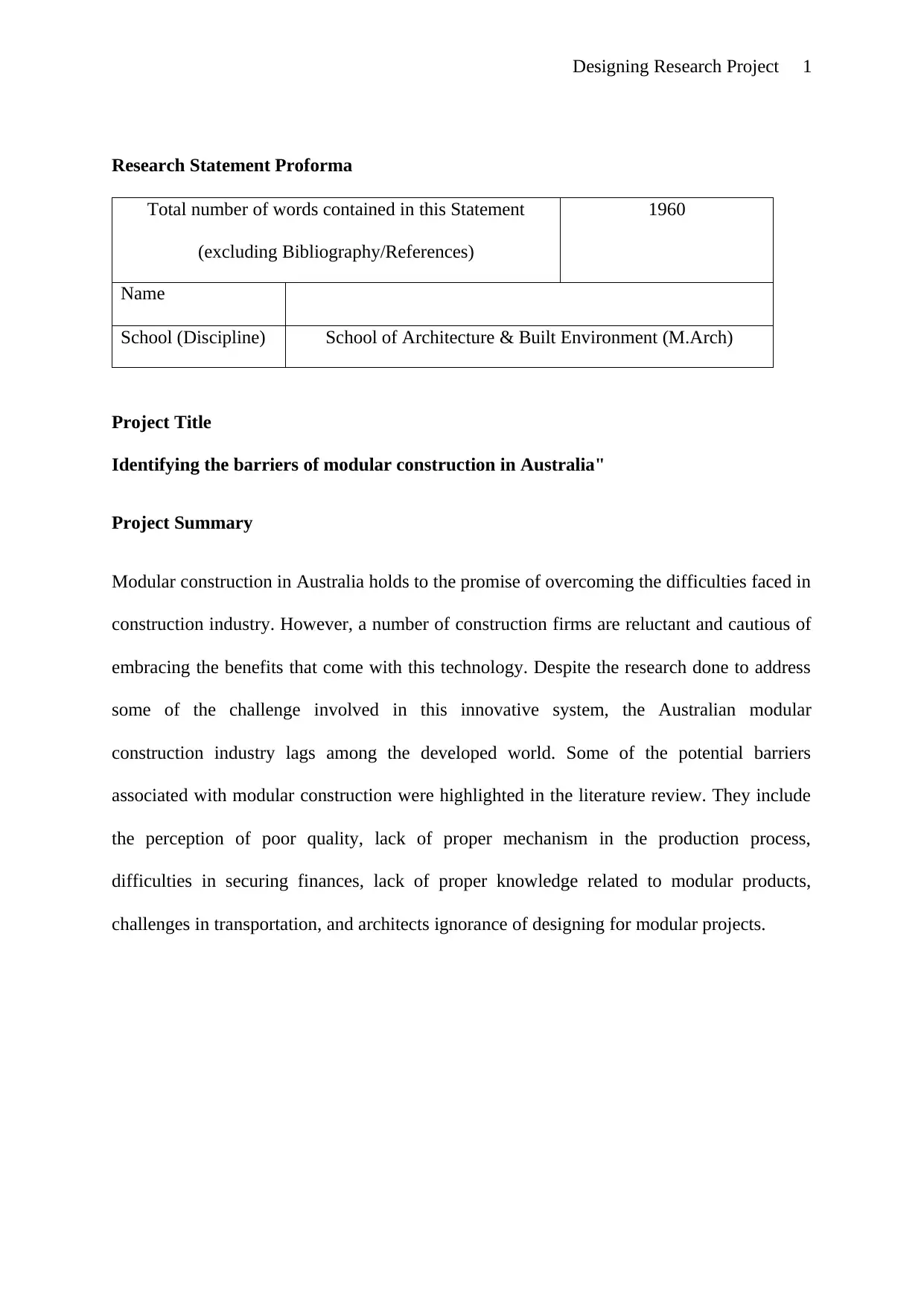
Designing Research Project 1
Research Statement Proforma
Total number of words contained in this Statement
(excluding Bibliography/References)
1960
Name
School (Discipline) School of Architecture & Built Environment (M.Arch)
Project Title
Identifying the barriers of modular construction in Australia"
Project Summary
Modular construction in Australia holds to the promise of overcoming the difficulties faced in
construction industry. However, a number of construction firms are reluctant and cautious of
embracing the benefits that come with this technology. Despite the research done to address
some of the challenge involved in this innovative system, the Australian modular
construction industry lags among the developed world. Some of the potential barriers
associated with modular construction were highlighted in the literature review. They include
the perception of poor quality, lack of proper mechanism in the production process,
difficulties in securing finances, lack of proper knowledge related to modular products,
challenges in transportation, and architects ignorance of designing for modular projects.
Research Statement Proforma
Total number of words contained in this Statement
(excluding Bibliography/References)
1960
Name
School (Discipline) School of Architecture & Built Environment (M.Arch)
Project Title
Identifying the barriers of modular construction in Australia"
Project Summary
Modular construction in Australia holds to the promise of overcoming the difficulties faced in
construction industry. However, a number of construction firms are reluctant and cautious of
embracing the benefits that come with this technology. Despite the research done to address
some of the challenge involved in this innovative system, the Australian modular
construction industry lags among the developed world. Some of the potential barriers
associated with modular construction were highlighted in the literature review. They include
the perception of poor quality, lack of proper mechanism in the production process,
difficulties in securing finances, lack of proper knowledge related to modular products,
challenges in transportation, and architects ignorance of designing for modular projects.
Paraphrase This Document
Need a fresh take? Get an instant paraphrase of this document with our AI Paraphraser
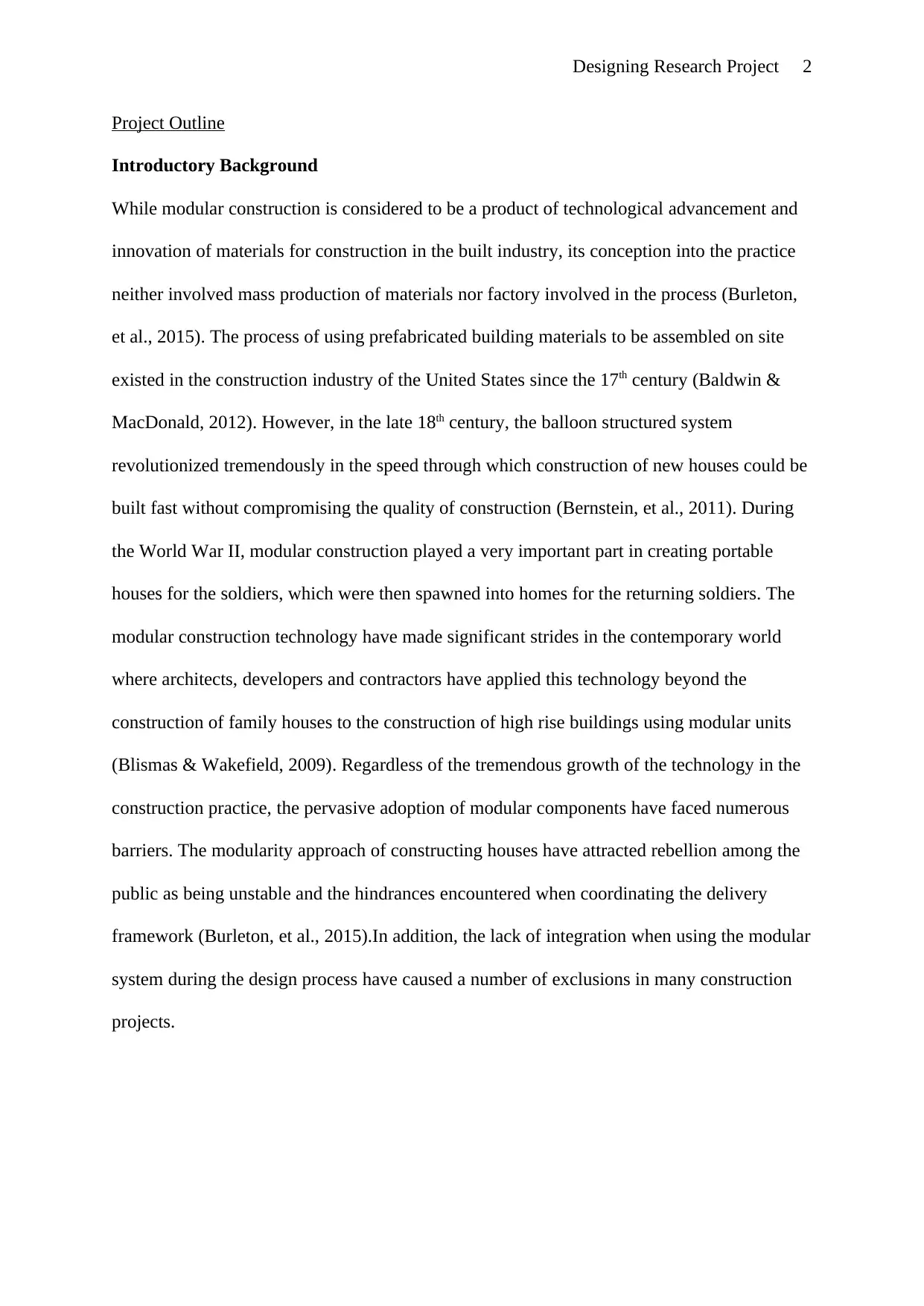
Designing Research Project 2
Project Outline
Introductory Background
While modular construction is considered to be a product of technological advancement and
innovation of materials for construction in the built industry, its conception into the practice
neither involved mass production of materials nor factory involved in the process (Burleton,
et al., 2015). The process of using prefabricated building materials to be assembled on site
existed in the construction industry of the United States since the 17th century (Baldwin &
MacDonald, 2012). However, in the late 18th century, the balloon structured system
revolutionized tremendously in the speed through which construction of new houses could be
built fast without compromising the quality of construction (Bernstein, et al., 2011). During
the World War II, modular construction played a very important part in creating portable
houses for the soldiers, which were then spawned into homes for the returning soldiers. The
modular construction technology have made significant strides in the contemporary world
where architects, developers and contractors have applied this technology beyond the
construction of family houses to the construction of high rise buildings using modular units
(Blismas & Wakefield, 2009). Regardless of the tremendous growth of the technology in the
construction practice, the pervasive adoption of modular components have faced numerous
barriers. The modularity approach of constructing houses have attracted rebellion among the
public as being unstable and the hindrances encountered when coordinating the delivery
framework (Burleton, et al., 2015).In addition, the lack of integration when using the modular
system during the design process have caused a number of exclusions in many construction
projects.
Project Outline
Introductory Background
While modular construction is considered to be a product of technological advancement and
innovation of materials for construction in the built industry, its conception into the practice
neither involved mass production of materials nor factory involved in the process (Burleton,
et al., 2015). The process of using prefabricated building materials to be assembled on site
existed in the construction industry of the United States since the 17th century (Baldwin &
MacDonald, 2012). However, in the late 18th century, the balloon structured system
revolutionized tremendously in the speed through which construction of new houses could be
built fast without compromising the quality of construction (Bernstein, et al., 2011). During
the World War II, modular construction played a very important part in creating portable
houses for the soldiers, which were then spawned into homes for the returning soldiers. The
modular construction technology have made significant strides in the contemporary world
where architects, developers and contractors have applied this technology beyond the
construction of family houses to the construction of high rise buildings using modular units
(Blismas & Wakefield, 2009). Regardless of the tremendous growth of the technology in the
construction practice, the pervasive adoption of modular components have faced numerous
barriers. The modularity approach of constructing houses have attracted rebellion among the
public as being unstable and the hindrances encountered when coordinating the delivery
framework (Burleton, et al., 2015).In addition, the lack of integration when using the modular
system during the design process have caused a number of exclusions in many construction
projects.
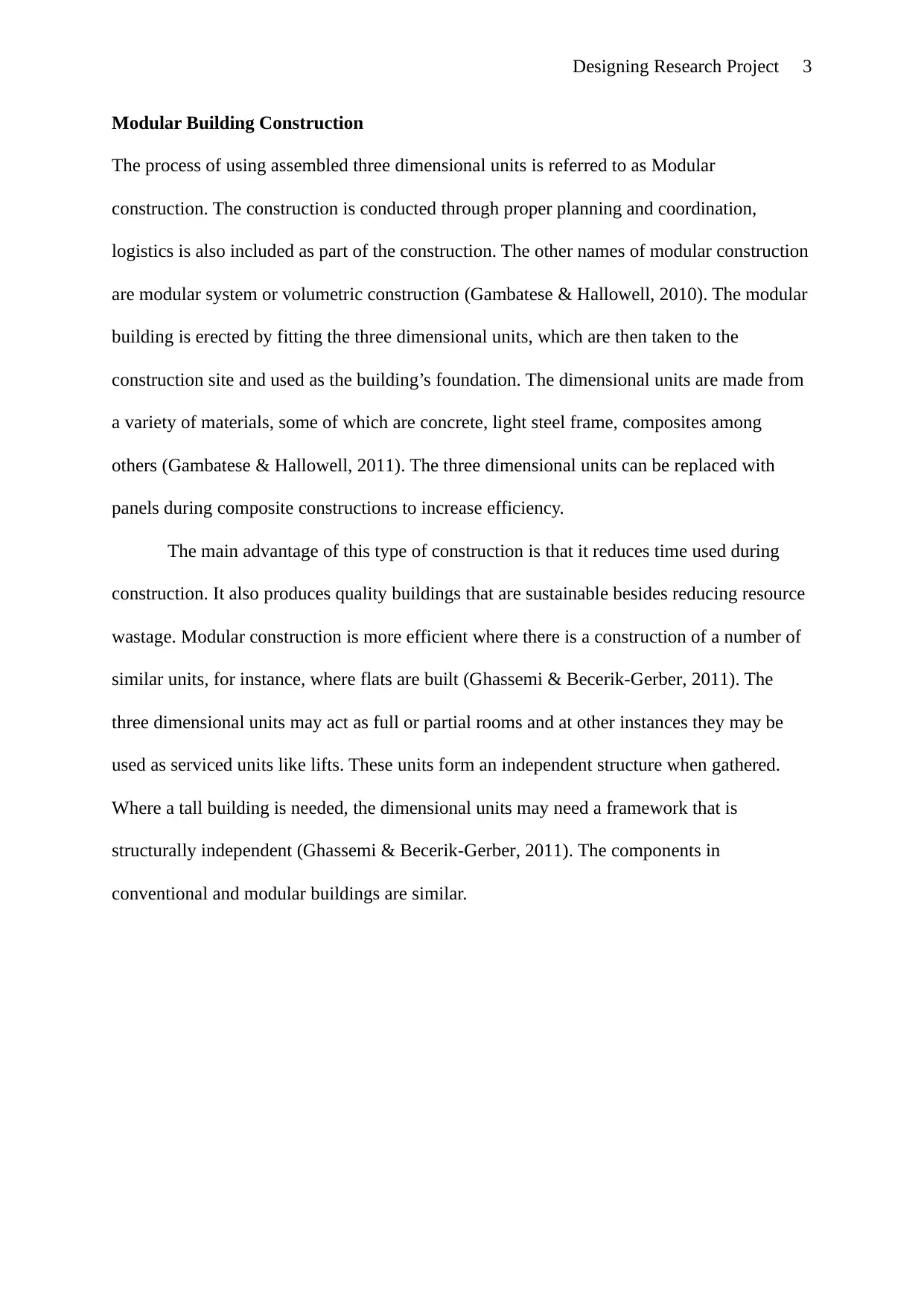
Designing Research Project 3
Modular Building Construction
The process of using assembled three dimensional units is referred to as Modular
construction. The construction is conducted through proper planning and coordination,
logistics is also included as part of the construction. The other names of modular construction
are modular system or volumetric construction (Gambatese & Hallowell, 2010). The modular
building is erected by fitting the three dimensional units, which are then taken to the
construction site and used as the building’s foundation. The dimensional units are made from
a variety of materials, some of which are concrete, light steel frame, composites among
others (Gambatese & Hallowell, 2011). The three dimensional units can be replaced with
panels during composite constructions to increase efficiency.
The main advantage of this type of construction is that it reduces time used during
construction. It also produces quality buildings that are sustainable besides reducing resource
wastage. Modular construction is more efficient where there is a construction of a number of
similar units, for instance, where flats are built (Ghassemi & Becerik-Gerber, 2011). The
three dimensional units may act as full or partial rooms and at other instances they may be
used as serviced units like lifts. These units form an independent structure when gathered.
Where a tall building is needed, the dimensional units may need a framework that is
structurally independent (Ghassemi & Becerik-Gerber, 2011). The components in
conventional and modular buildings are similar.
Modular Building Construction
The process of using assembled three dimensional units is referred to as Modular
construction. The construction is conducted through proper planning and coordination,
logistics is also included as part of the construction. The other names of modular construction
are modular system or volumetric construction (Gambatese & Hallowell, 2010). The modular
building is erected by fitting the three dimensional units, which are then taken to the
construction site and used as the building’s foundation. The dimensional units are made from
a variety of materials, some of which are concrete, light steel frame, composites among
others (Gambatese & Hallowell, 2011). The three dimensional units can be replaced with
panels during composite constructions to increase efficiency.
The main advantage of this type of construction is that it reduces time used during
construction. It also produces quality buildings that are sustainable besides reducing resource
wastage. Modular construction is more efficient where there is a construction of a number of
similar units, for instance, where flats are built (Ghassemi & Becerik-Gerber, 2011). The
three dimensional units may act as full or partial rooms and at other instances they may be
used as serviced units like lifts. These units form an independent structure when gathered.
Where a tall building is needed, the dimensional units may need a framework that is
structurally independent (Ghassemi & Becerik-Gerber, 2011). The components in
conventional and modular buildings are similar.
⊘ This is a preview!⊘
Do you want full access?
Subscribe today to unlock all pages.

Trusted by 1+ million students worldwide
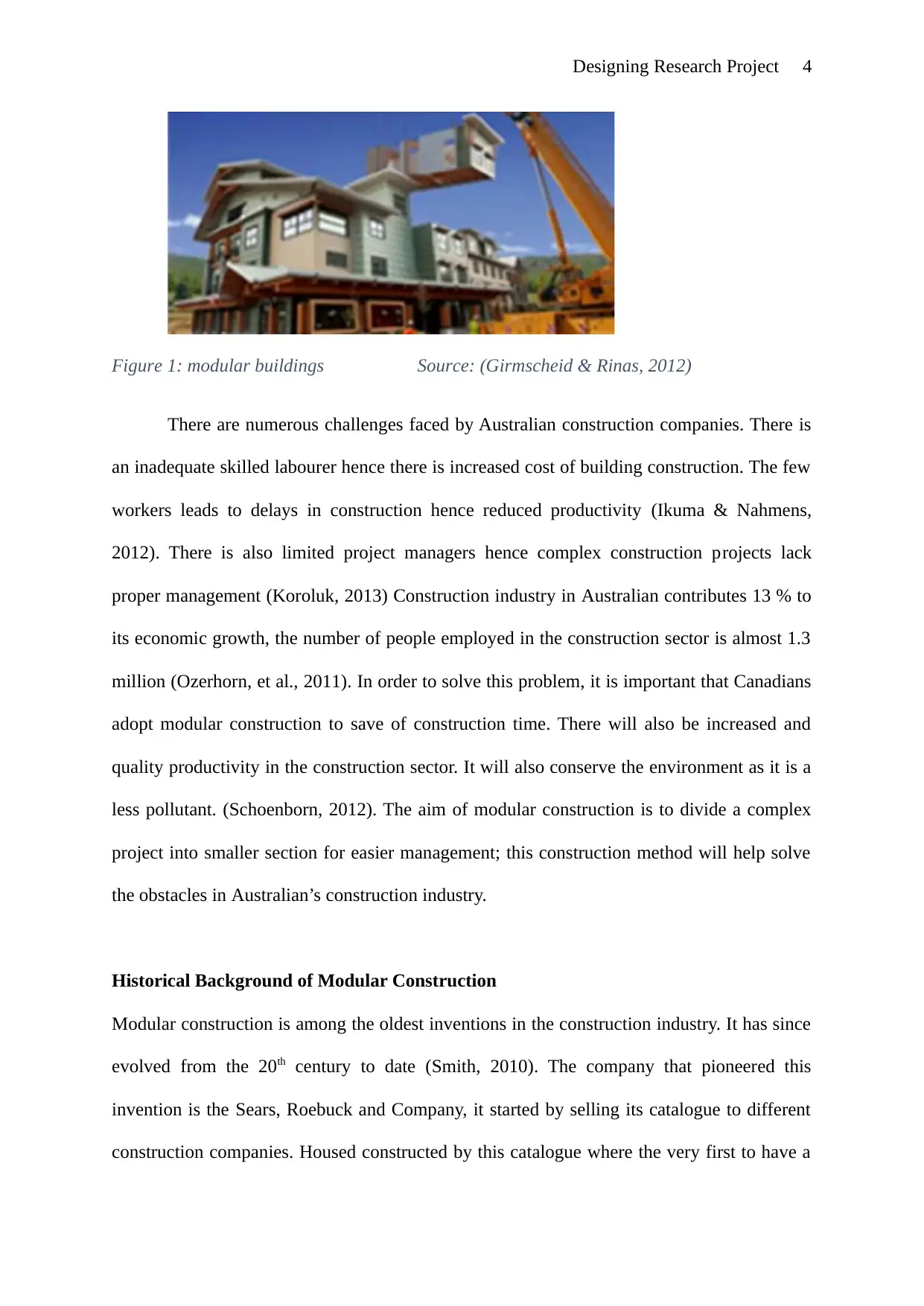
Designing Research Project 4
Figure 1: modular buildings Source: (Girmscheid & Rinas, 2012)
There are numerous challenges faced by Australian construction companies. There is
an inadequate skilled labourer hence there is increased cost of building construction. The few
workers leads to delays in construction hence reduced productivity (Ikuma & Nahmens,
2012). There is also limited project managers hence complex construction projects lack
proper management (Koroluk, 2013) Construction industry in Australian contributes 13 % to
its economic growth, the number of people employed in the construction sector is almost 1.3
million (Ozerhorn, et al., 2011). In order to solve this problem, it is important that Canadians
adopt modular construction to save of construction time. There will also be increased and
quality productivity in the construction sector. It will also conserve the environment as it is a
less pollutant. (Schoenborn, 2012). The aim of modular construction is to divide a complex
project into smaller section for easier management; this construction method will help solve
the obstacles in Australian’s construction industry.
Historical Background of Modular Construction
Modular construction is among the oldest inventions in the construction industry. It has since
evolved from the 20th century to date (Smith, 2010). The company that pioneered this
invention is the Sears, Roebuck and Company, it started by selling its catalogue to different
construction companies. Housed constructed by this catalogue where the very first to have a
Figure 1: modular buildings Source: (Girmscheid & Rinas, 2012)
There are numerous challenges faced by Australian construction companies. There is
an inadequate skilled labourer hence there is increased cost of building construction. The few
workers leads to delays in construction hence reduced productivity (Ikuma & Nahmens,
2012). There is also limited project managers hence complex construction projects lack
proper management (Koroluk, 2013) Construction industry in Australian contributes 13 % to
its economic growth, the number of people employed in the construction sector is almost 1.3
million (Ozerhorn, et al., 2011). In order to solve this problem, it is important that Canadians
adopt modular construction to save of construction time. There will also be increased and
quality productivity in the construction sector. It will also conserve the environment as it is a
less pollutant. (Schoenborn, 2012). The aim of modular construction is to divide a complex
project into smaller section for easier management; this construction method will help solve
the obstacles in Australian’s construction industry.
Historical Background of Modular Construction
Modular construction is among the oldest inventions in the construction industry. It has since
evolved from the 20th century to date (Smith, 2010). The company that pioneered this
invention is the Sears, Roebuck and Company, it started by selling its catalogue to different
construction companies. Housed constructed by this catalogue where the very first to have a
Paraphrase This Document
Need a fresh take? Get an instant paraphrase of this document with our AI Paraphraser
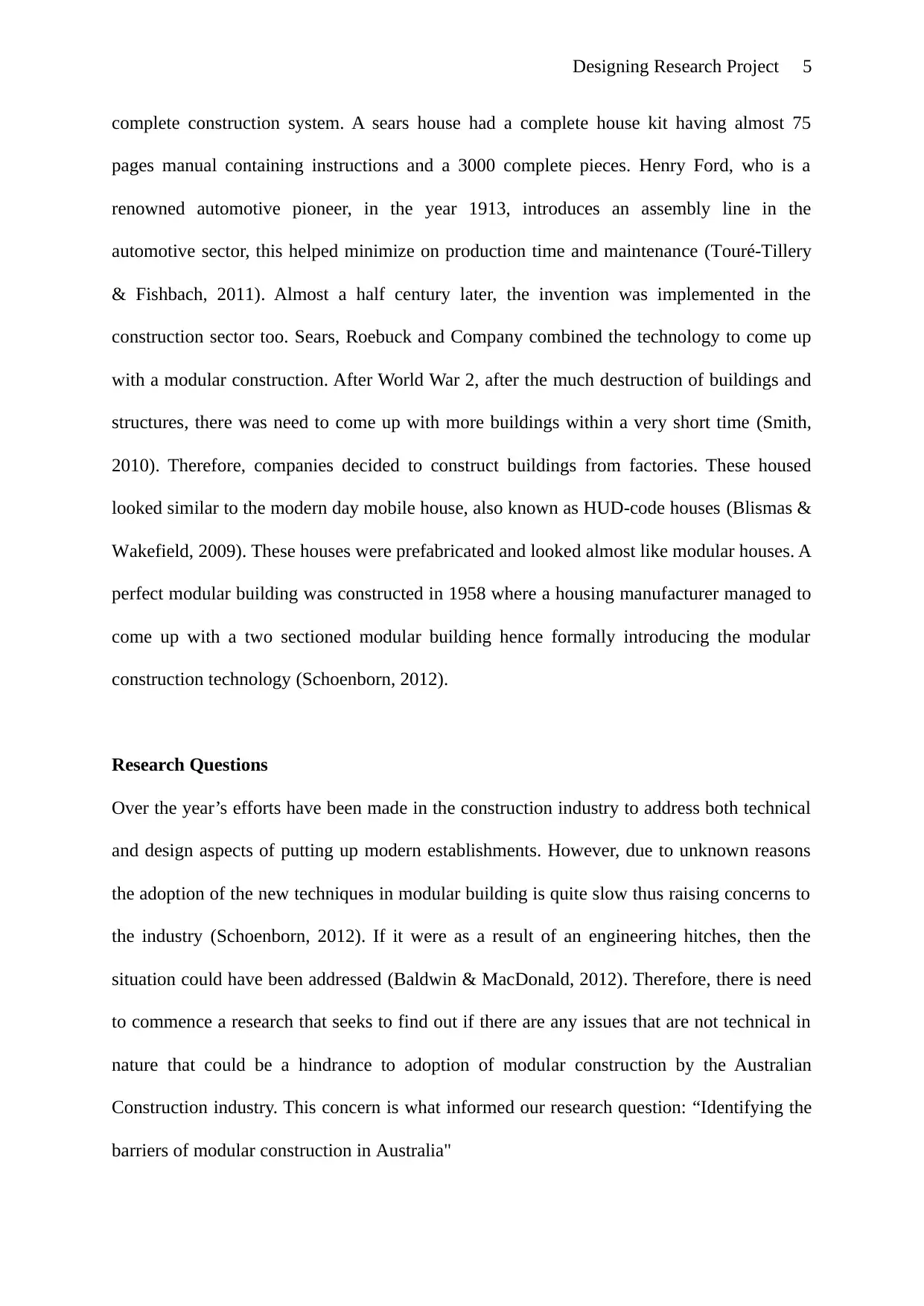
Designing Research Project 5
complete construction system. A sears house had a complete house kit having almost 75
pages manual containing instructions and a 3000 complete pieces. Henry Ford, who is a
renowned automotive pioneer, in the year 1913, introduces an assembly line in the
automotive sector, this helped minimize on production time and maintenance (Touré-Tillery
& Fishbach, 2011). Almost a half century later, the invention was implemented in the
construction sector too. Sears, Roebuck and Company combined the technology to come up
with a modular construction. After World War 2, after the much destruction of buildings and
structures, there was need to come up with more buildings within a very short time (Smith,
2010). Therefore, companies decided to construct buildings from factories. These housed
looked similar to the modern day mobile house, also known as HUD-code houses (Blismas &
Wakefield, 2009). These houses were prefabricated and looked almost like modular houses. A
perfect modular building was constructed in 1958 where a housing manufacturer managed to
come up with a two sectioned modular building hence formally introducing the modular
construction technology (Schoenborn, 2012).
Research Questions
Over the year’s efforts have been made in the construction industry to address both technical
and design aspects of putting up modern establishments. However, due to unknown reasons
the adoption of the new techniques in modular building is quite slow thus raising concerns to
the industry (Schoenborn, 2012). If it were as a result of an engineering hitches, then the
situation could have been addressed (Baldwin & MacDonald, 2012). Therefore, there is need
to commence a research that seeks to find out if there are any issues that are not technical in
nature that could be a hindrance to adoption of modular construction by the Australian
Construction industry. This concern is what informed our research question: “Identifying the
barriers of modular construction in Australia"
complete construction system. A sears house had a complete house kit having almost 75
pages manual containing instructions and a 3000 complete pieces. Henry Ford, who is a
renowned automotive pioneer, in the year 1913, introduces an assembly line in the
automotive sector, this helped minimize on production time and maintenance (Touré-Tillery
& Fishbach, 2011). Almost a half century later, the invention was implemented in the
construction sector too. Sears, Roebuck and Company combined the technology to come up
with a modular construction. After World War 2, after the much destruction of buildings and
structures, there was need to come up with more buildings within a very short time (Smith,
2010). Therefore, companies decided to construct buildings from factories. These housed
looked similar to the modern day mobile house, also known as HUD-code houses (Blismas &
Wakefield, 2009). These houses were prefabricated and looked almost like modular houses. A
perfect modular building was constructed in 1958 where a housing manufacturer managed to
come up with a two sectioned modular building hence formally introducing the modular
construction technology (Schoenborn, 2012).
Research Questions
Over the year’s efforts have been made in the construction industry to address both technical
and design aspects of putting up modern establishments. However, due to unknown reasons
the adoption of the new techniques in modular building is quite slow thus raising concerns to
the industry (Schoenborn, 2012). If it were as a result of an engineering hitches, then the
situation could have been addressed (Baldwin & MacDonald, 2012). Therefore, there is need
to commence a research that seeks to find out if there are any issues that are not technical in
nature that could be a hindrance to adoption of modular construction by the Australian
Construction industry. This concern is what informed our research question: “Identifying the
barriers of modular construction in Australia"
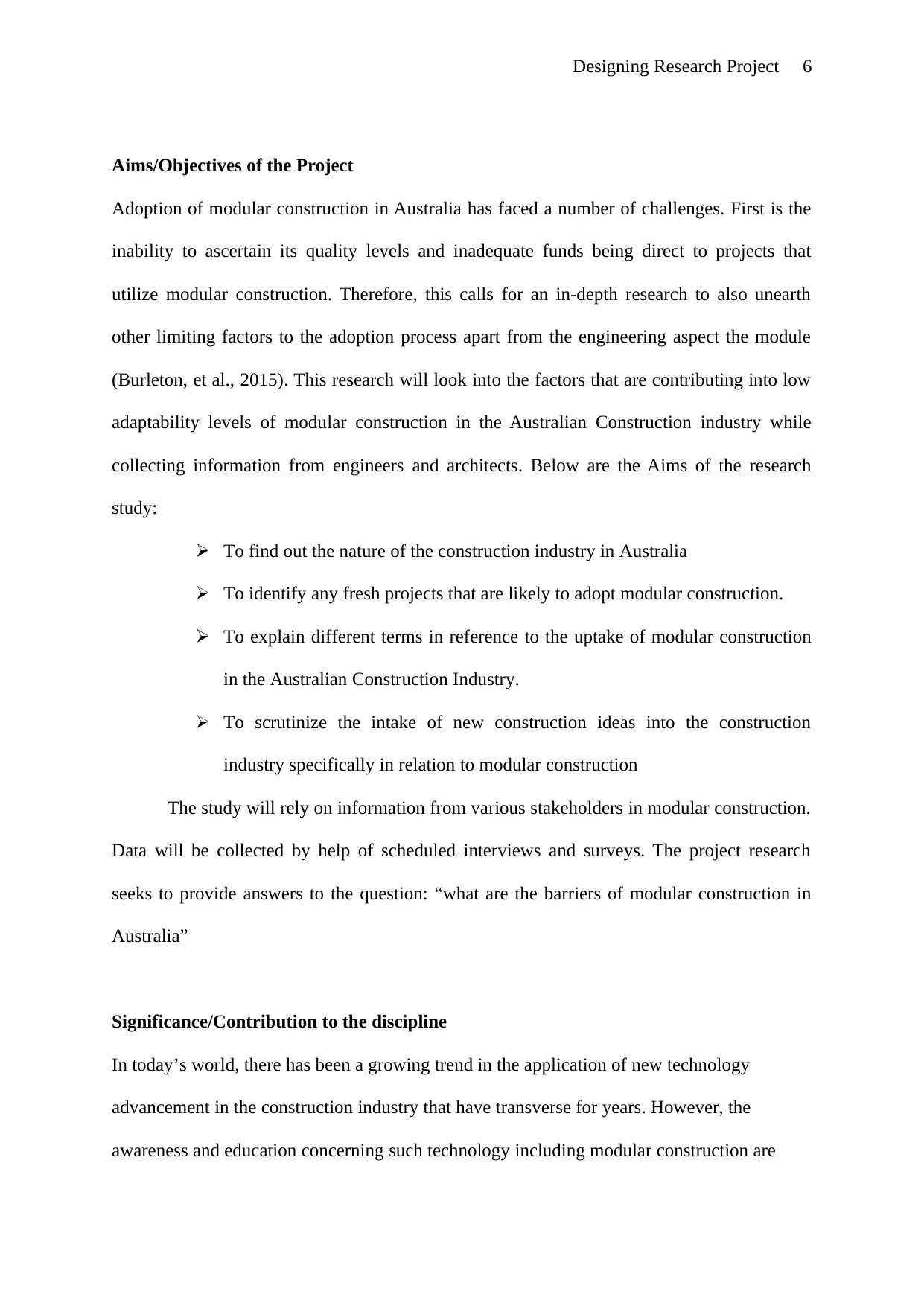
Designing Research Project 6
Aims/Objectives of the Project
Adoption of modular construction in Australia has faced a number of challenges. First is the
inability to ascertain its quality levels and inadequate funds being direct to projects that
utilize modular construction. Therefore, this calls for an in-depth research to also unearth
other limiting factors to the adoption process apart from the engineering aspect the module
(Burleton, et al., 2015). This research will look into the factors that are contributing into low
adaptability levels of modular construction in the Australian Construction industry while
collecting information from engineers and architects. Below are the Aims of the research
study:
To find out the nature of the construction industry in Australia
To identify any fresh projects that are likely to adopt modular construction.
To explain different terms in reference to the uptake of modular construction
in the Australian Construction Industry.
To scrutinize the intake of new construction ideas into the construction
industry specifically in relation to modular construction
The study will rely on information from various stakeholders in modular construction.
Data will be collected by help of scheduled interviews and surveys. The project research
seeks to provide answers to the question: “what are the barriers of modular construction in
Australia”
Significance/Contribution to the discipline
In today’s world, there has been a growing trend in the application of new technology
advancement in the construction industry that have transverse for years. However, the
awareness and education concerning such technology including modular construction are
Aims/Objectives of the Project
Adoption of modular construction in Australia has faced a number of challenges. First is the
inability to ascertain its quality levels and inadequate funds being direct to projects that
utilize modular construction. Therefore, this calls for an in-depth research to also unearth
other limiting factors to the adoption process apart from the engineering aspect the module
(Burleton, et al., 2015). This research will look into the factors that are contributing into low
adaptability levels of modular construction in the Australian Construction industry while
collecting information from engineers and architects. Below are the Aims of the research
study:
To find out the nature of the construction industry in Australia
To identify any fresh projects that are likely to adopt modular construction.
To explain different terms in reference to the uptake of modular construction
in the Australian Construction Industry.
To scrutinize the intake of new construction ideas into the construction
industry specifically in relation to modular construction
The study will rely on information from various stakeholders in modular construction.
Data will be collected by help of scheduled interviews and surveys. The project research
seeks to provide answers to the question: “what are the barriers of modular construction in
Australia”
Significance/Contribution to the discipline
In today’s world, there has been a growing trend in the application of new technology
advancement in the construction industry that have transverse for years. However, the
awareness and education concerning such technology including modular construction are
⊘ This is a preview!⊘
Do you want full access?
Subscribe today to unlock all pages.

Trusted by 1+ million students worldwide
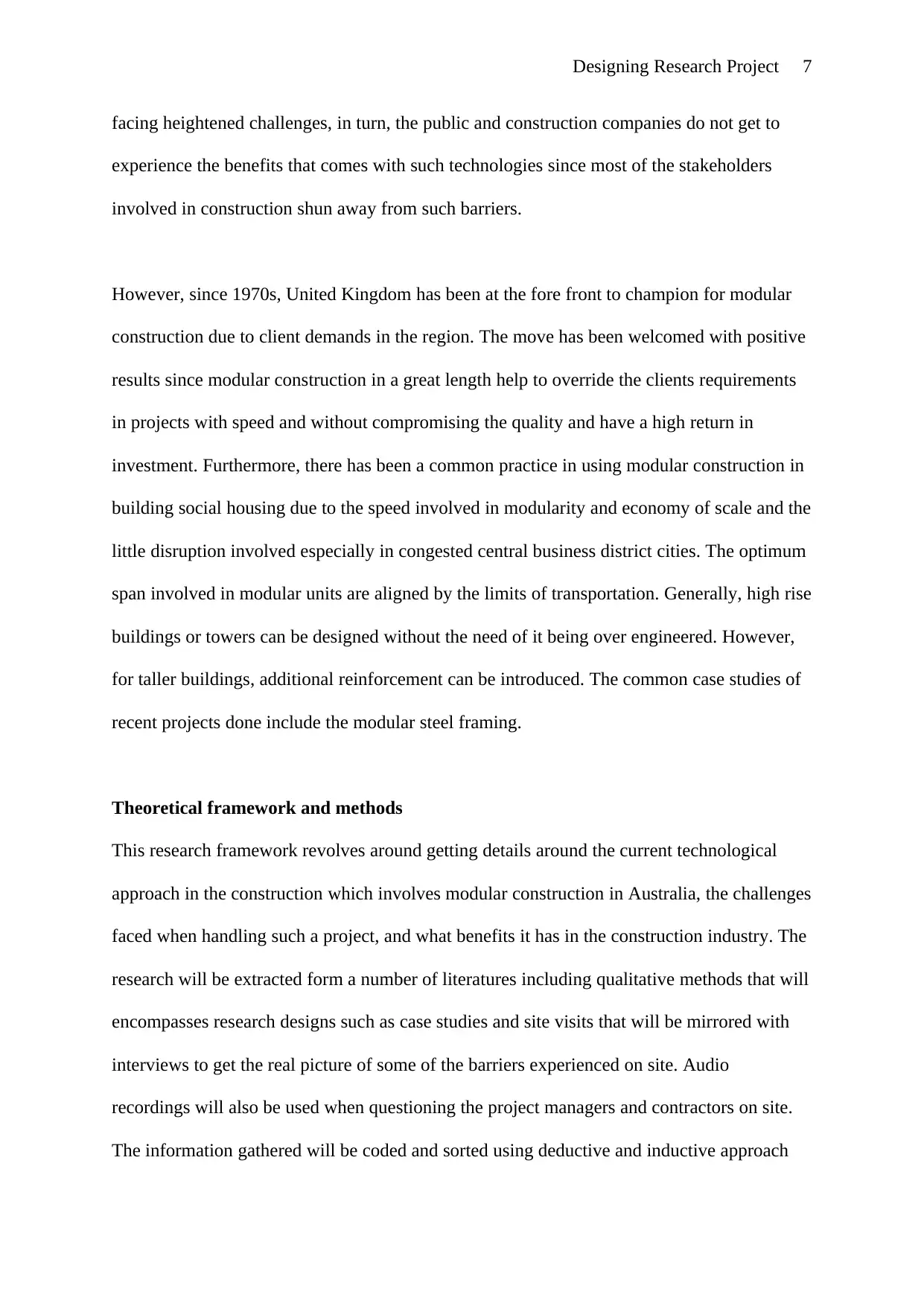
Designing Research Project 7
facing heightened challenges, in turn, the public and construction companies do not get to
experience the benefits that comes with such technologies since most of the stakeholders
involved in construction shun away from such barriers.
However, since 1970s, United Kingdom has been at the fore front to champion for modular
construction due to client demands in the region. The move has been welcomed with positive
results since modular construction in a great length help to override the clients requirements
in projects with speed and without compromising the quality and have a high return in
investment. Furthermore, there has been a common practice in using modular construction in
building social housing due to the speed involved in modularity and economy of scale and the
little disruption involved especially in congested central business district cities. The optimum
span involved in modular units are aligned by the limits of transportation. Generally, high rise
buildings or towers can be designed without the need of it being over engineered. However,
for taller buildings, additional reinforcement can be introduced. The common case studies of
recent projects done include the modular steel framing.
Theoretical framework and methods
This research framework revolves around getting details around the current technological
approach in the construction which involves modular construction in Australia, the challenges
faced when handling such a project, and what benefits it has in the construction industry. The
research will be extracted form a number of literatures including qualitative methods that will
encompasses research designs such as case studies and site visits that will be mirrored with
interviews to get the real picture of some of the barriers experienced on site. Audio
recordings will also be used when questioning the project managers and contractors on site.
The information gathered will be coded and sorted using deductive and inductive approach
facing heightened challenges, in turn, the public and construction companies do not get to
experience the benefits that comes with such technologies since most of the stakeholders
involved in construction shun away from such barriers.
However, since 1970s, United Kingdom has been at the fore front to champion for modular
construction due to client demands in the region. The move has been welcomed with positive
results since modular construction in a great length help to override the clients requirements
in projects with speed and without compromising the quality and have a high return in
investment. Furthermore, there has been a common practice in using modular construction in
building social housing due to the speed involved in modularity and economy of scale and the
little disruption involved especially in congested central business district cities. The optimum
span involved in modular units are aligned by the limits of transportation. Generally, high rise
buildings or towers can be designed without the need of it being over engineered. However,
for taller buildings, additional reinforcement can be introduced. The common case studies of
recent projects done include the modular steel framing.
Theoretical framework and methods
This research framework revolves around getting details around the current technological
approach in the construction which involves modular construction in Australia, the challenges
faced when handling such a project, and what benefits it has in the construction industry. The
research will be extracted form a number of literatures including qualitative methods that will
encompasses research designs such as case studies and site visits that will be mirrored with
interviews to get the real picture of some of the barriers experienced on site. Audio
recordings will also be used when questioning the project managers and contractors on site.
The information gathered will be coded and sorted using deductive and inductive approach
Paraphrase This Document
Need a fresh take? Get an instant paraphrase of this document with our AI Paraphraser
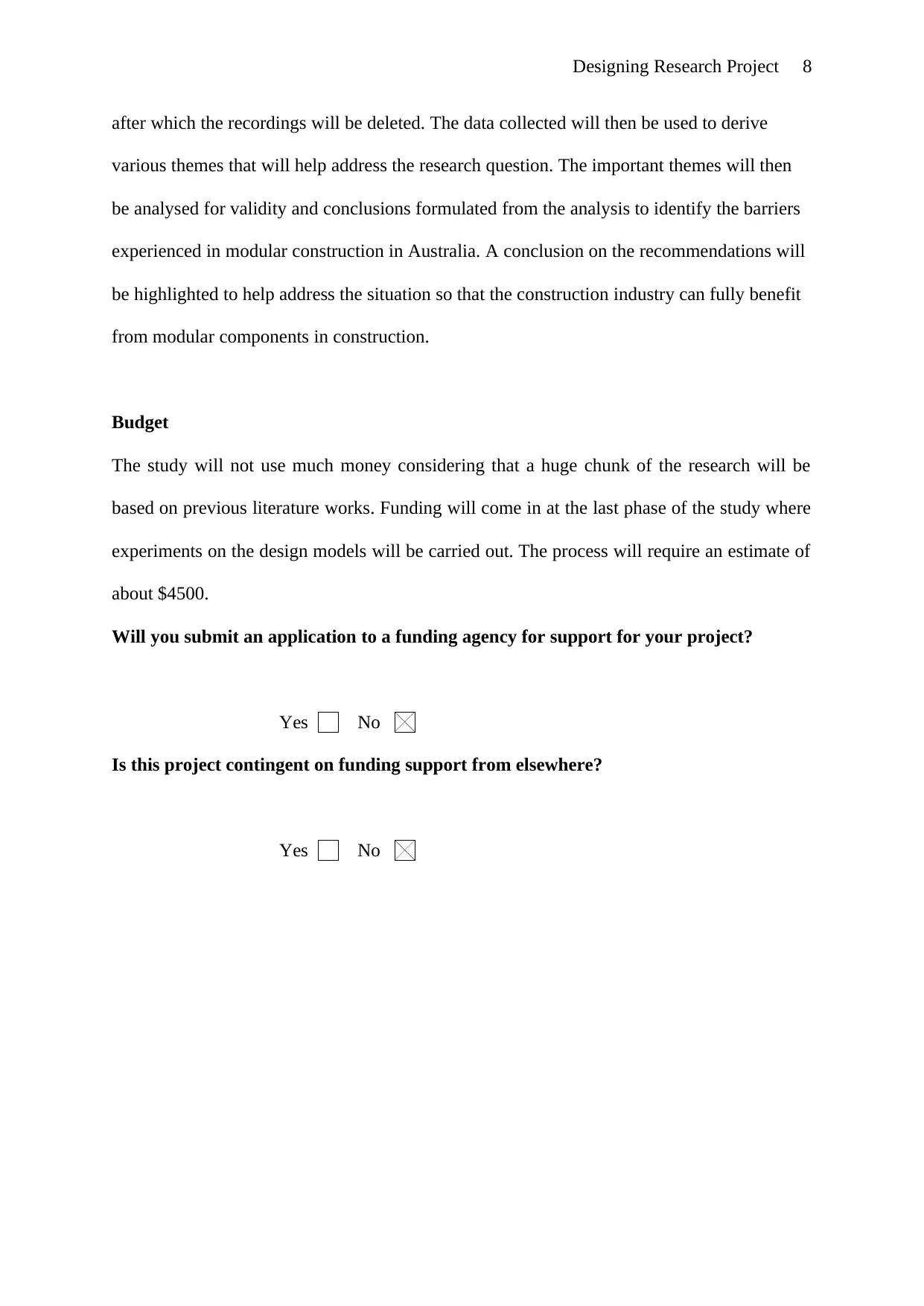
Designing Research Project 8
after which the recordings will be deleted. The data collected will then be used to derive
various themes that will help address the research question. The important themes will then
be analysed for validity and conclusions formulated from the analysis to identify the barriers
experienced in modular construction in Australia. A conclusion on the recommendations will
be highlighted to help address the situation so that the construction industry can fully benefit
from modular components in construction.
Budget
The study will not use much money considering that a huge chunk of the research will be
based on previous literature works. Funding will come in at the last phase of the study where
experiments on the design models will be carried out. The process will require an estimate of
about $4500.
Will you submit an application to a funding agency for support for your project?
Yes No
Is this project contingent on funding support from elsewhere?
Yes No
after which the recordings will be deleted. The data collected will then be used to derive
various themes that will help address the research question. The important themes will then
be analysed for validity and conclusions formulated from the analysis to identify the barriers
experienced in modular construction in Australia. A conclusion on the recommendations will
be highlighted to help address the situation so that the construction industry can fully benefit
from modular components in construction.
Budget
The study will not use much money considering that a huge chunk of the research will be
based on previous literature works. Funding will come in at the last phase of the study where
experiments on the design models will be carried out. The process will require an estimate of
about $4500.
Will you submit an application to a funding agency for support for your project?
Yes No
Is this project contingent on funding support from elsewhere?
Yes No
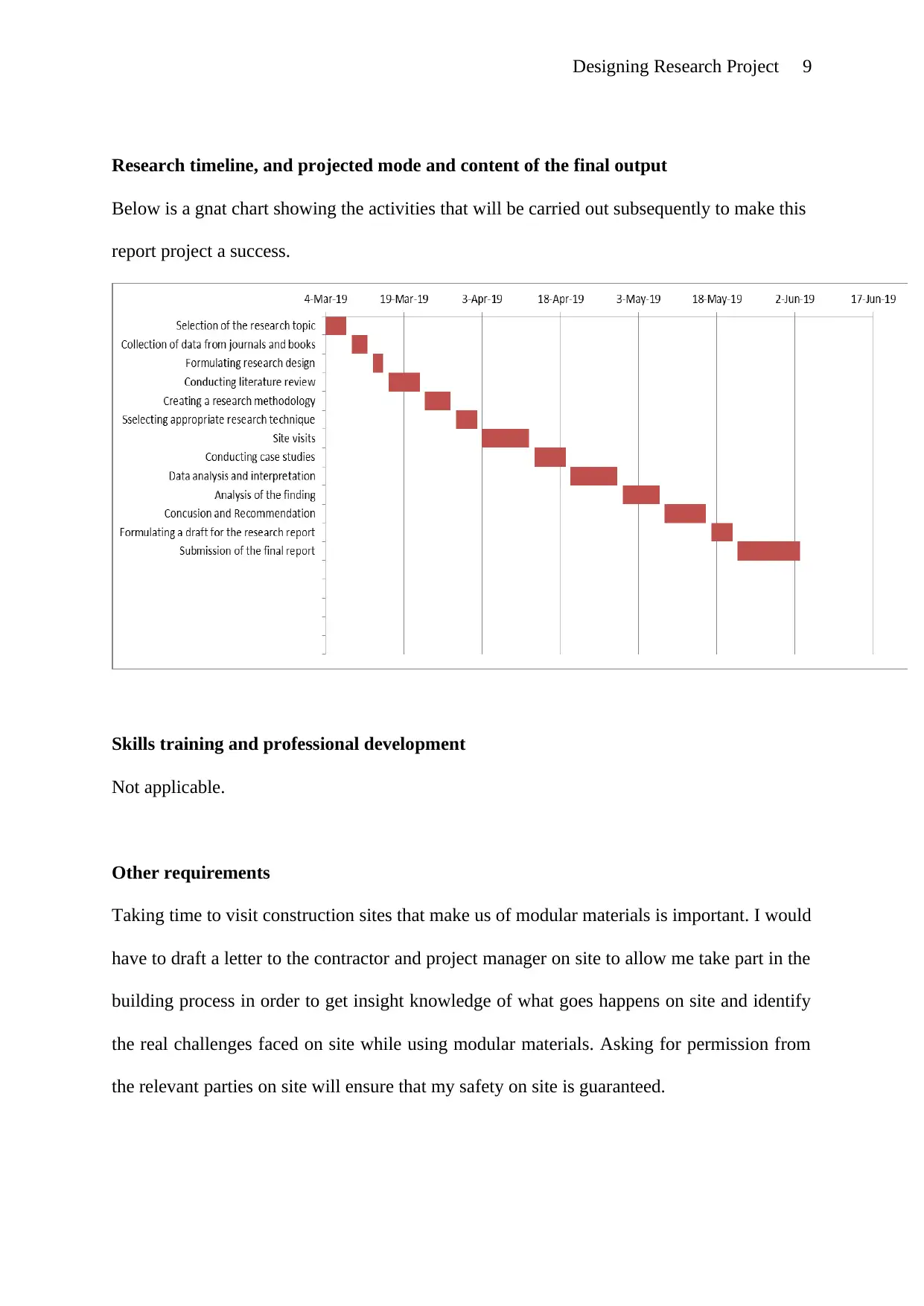
Designing Research Project 9
Research timeline, and projected mode and content of the final output
Below is a gnat chart showing the activities that will be carried out subsequently to make this
report project a success.
Skills training and professional development
Not applicable.
Other requirements
Taking time to visit construction sites that make us of modular materials is important. I would
have to draft a letter to the contractor and project manager on site to allow me take part in the
building process in order to get insight knowledge of what goes happens on site and identify
the real challenges faced on site while using modular materials. Asking for permission from
the relevant parties on site will ensure that my safety on site is guaranteed.
Research timeline, and projected mode and content of the final output
Below is a gnat chart showing the activities that will be carried out subsequently to make this
report project a success.
Skills training and professional development
Not applicable.
Other requirements
Taking time to visit construction sites that make us of modular materials is important. I would
have to draft a letter to the contractor and project manager on site to allow me take part in the
building process in order to get insight knowledge of what goes happens on site and identify
the real challenges faced on site while using modular materials. Asking for permission from
the relevant parties on site will ensure that my safety on site is guaranteed.
⊘ This is a preview!⊘
Do you want full access?
Subscribe today to unlock all pages.

Trusted by 1+ million students worldwide
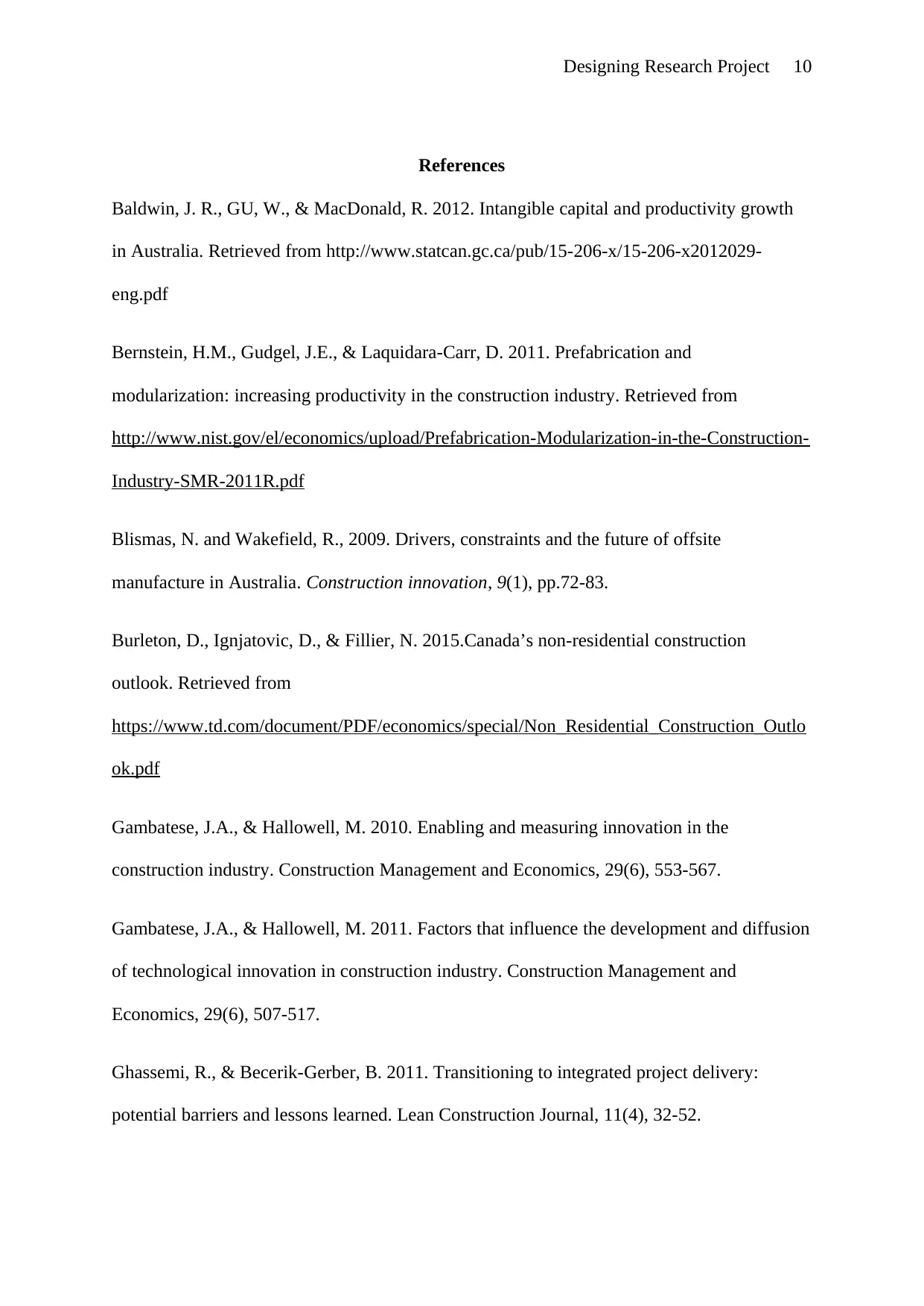
Designing Research Project 10
References
Baldwin, J. R., GU, W., & MacDonald, R. 2012. Intangible capital and productivity growth
in Australia. Retrieved from http://www.statcan.gc.ca/pub/15-206-x/15-206-x2012029-
eng.pdf
Bernstein, H.M., Gudgel, J.E., & Laquidara-Carr, D. 2011. Prefabrication and
modularization: increasing productivity in the construction industry. Retrieved from
http://www.nist.gov/el/economics/upload/Prefabrication-Modularization-in-the-Construction-
Industry-SMR-2011R.pdf
Blismas, N. and Wakefield, R., 2009. Drivers, constraints and the future of offsite
manufacture in Australia. Construction innovation, 9(1), pp.72-83.
Burleton, D., Ignjatovic, D., & Fillier, N. 2015.Canada’s non-residential construction
outlook. Retrieved from
https://www.td.com/document/PDF/economics/special/Non_Residential_Construction_Outlo
ok.pdf
Gambatese, J.A., & Hallowell, M. 2010. Enabling and measuring innovation in the
construction industry. Construction Management and Economics, 29(6), 553-567.
Gambatese, J.A., & Hallowell, M. 2011. Factors that influence the development and diffusion
of technological innovation in construction industry. Construction Management and
Economics, 29(6), 507-517.
Ghassemi, R., & Becerik-Gerber, B. 2011. Transitioning to integrated project delivery:
potential barriers and lessons learned. Lean Construction Journal, 11(4), 32-52.
References
Baldwin, J. R., GU, W., & MacDonald, R. 2012. Intangible capital and productivity growth
in Australia. Retrieved from http://www.statcan.gc.ca/pub/15-206-x/15-206-x2012029-
eng.pdf
Bernstein, H.M., Gudgel, J.E., & Laquidara-Carr, D. 2011. Prefabrication and
modularization: increasing productivity in the construction industry. Retrieved from
http://www.nist.gov/el/economics/upload/Prefabrication-Modularization-in-the-Construction-
Industry-SMR-2011R.pdf
Blismas, N. and Wakefield, R., 2009. Drivers, constraints and the future of offsite
manufacture in Australia. Construction innovation, 9(1), pp.72-83.
Burleton, D., Ignjatovic, D., & Fillier, N. 2015.Canada’s non-residential construction
outlook. Retrieved from
https://www.td.com/document/PDF/economics/special/Non_Residential_Construction_Outlo
ok.pdf
Gambatese, J.A., & Hallowell, M. 2010. Enabling and measuring innovation in the
construction industry. Construction Management and Economics, 29(6), 553-567.
Gambatese, J.A., & Hallowell, M. 2011. Factors that influence the development and diffusion
of technological innovation in construction industry. Construction Management and
Economics, 29(6), 507-517.
Ghassemi, R., & Becerik-Gerber, B. 2011. Transitioning to integrated project delivery:
potential barriers and lessons learned. Lean Construction Journal, 11(4), 32-52.
Paraphrase This Document
Need a fresh take? Get an instant paraphrase of this document with our AI Paraphraser
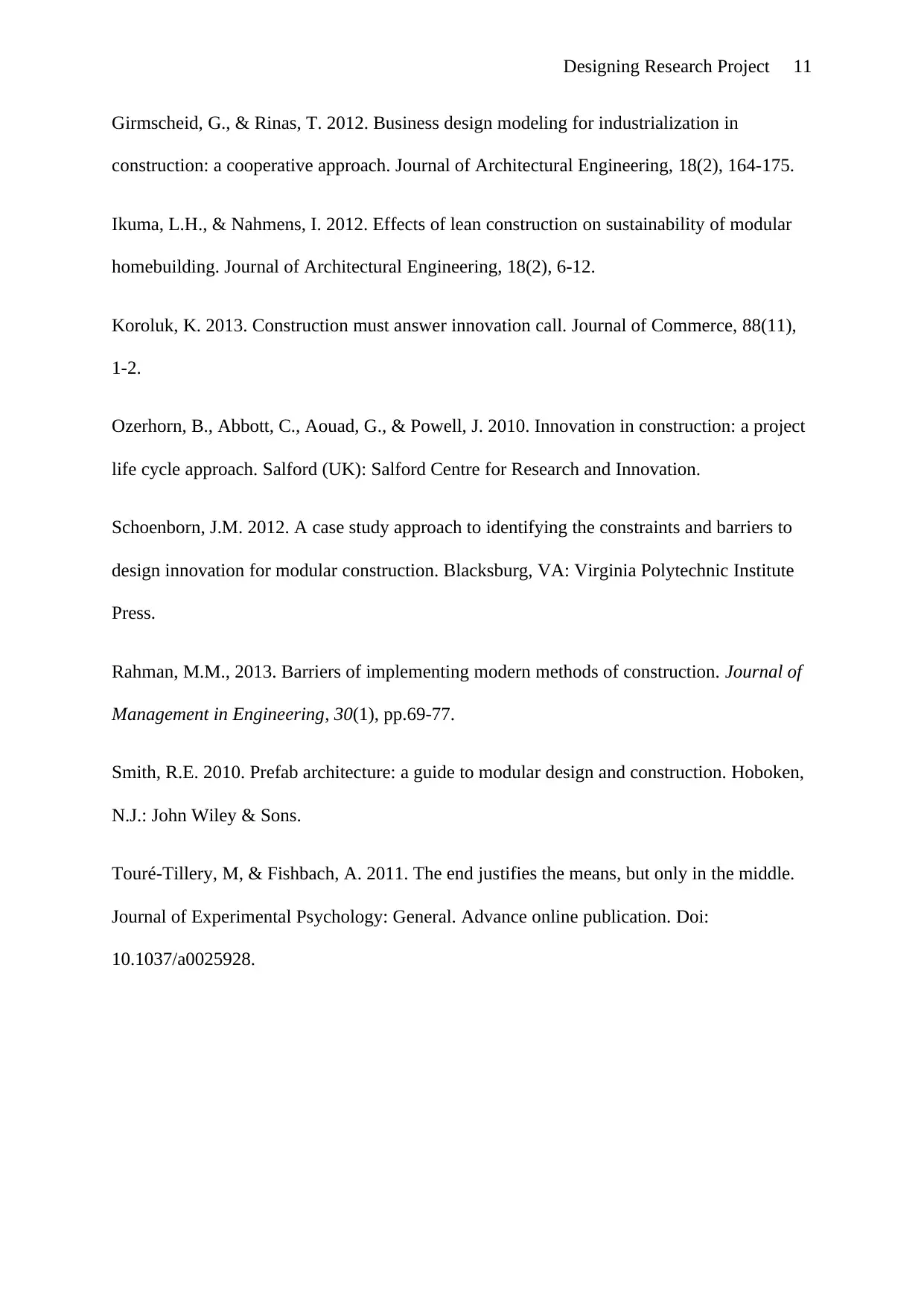
Designing Research Project 11
Girmscheid, G., & Rinas, T. 2012. Business design modeling for industrialization in
construction: a cooperative approach. Journal of Architectural Engineering, 18(2), 164-175.
Ikuma, L.H., & Nahmens, I. 2012. Effects of lean construction on sustainability of modular
homebuilding. Journal of Architectural Engineering, 18(2), 6-12.
Koroluk, K. 2013. Construction must answer innovation call. Journal of Commerce, 88(11),
1-2.
Ozerhorn, B., Abbott, C., Aouad, G., & Powell, J. 2010. Innovation in construction: a project
life cycle approach. Salford (UK): Salford Centre for Research and Innovation.
Schoenborn, J.M. 2012. A case study approach to identifying the constraints and barriers to
design innovation for modular construction. Blacksburg, VA: Virginia Polytechnic Institute
Press.
Rahman, M.M., 2013. Barriers of implementing modern methods of construction. Journal of
Management in Engineering, 30(1), pp.69-77.
Smith, R.E. 2010. Prefab architecture: a guide to modular design and construction. Hoboken,
N.J.: John Wiley & Sons.
Touré-Tillery, M, & Fishbach, A. 2011. The end justifies the means, but only in the middle.
Journal of Experimental Psychology: General. Advance online publication. Doi:
10.1037/a0025928.
Girmscheid, G., & Rinas, T. 2012. Business design modeling for industrialization in
construction: a cooperative approach. Journal of Architectural Engineering, 18(2), 164-175.
Ikuma, L.H., & Nahmens, I. 2012. Effects of lean construction on sustainability of modular
homebuilding. Journal of Architectural Engineering, 18(2), 6-12.
Koroluk, K. 2013. Construction must answer innovation call. Journal of Commerce, 88(11),
1-2.
Ozerhorn, B., Abbott, C., Aouad, G., & Powell, J. 2010. Innovation in construction: a project
life cycle approach. Salford (UK): Salford Centre for Research and Innovation.
Schoenborn, J.M. 2012. A case study approach to identifying the constraints and barriers to
design innovation for modular construction. Blacksburg, VA: Virginia Polytechnic Institute
Press.
Rahman, M.M., 2013. Barriers of implementing modern methods of construction. Journal of
Management in Engineering, 30(1), pp.69-77.
Smith, R.E. 2010. Prefab architecture: a guide to modular design and construction. Hoboken,
N.J.: John Wiley & Sons.
Touré-Tillery, M, & Fishbach, A. 2011. The end justifies the means, but only in the middle.
Journal of Experimental Psychology: General. Advance online publication. Doi:
10.1037/a0025928.

Designing Research Project 12
SIGNED: (*deleted for confidentiality)
NAME (BLOCK CAPITALS): (*deleted for confidentiality)
DATE:
SIGNED: (*deleted for confidentiality)
NAME (BLOCK CAPITALS): (*deleted for confidentiality)
DATE:
⊘ This is a preview!⊘
Do you want full access?
Subscribe today to unlock all pages.

Trusted by 1+ million students worldwide
1 out of 12
Related Documents
Your All-in-One AI-Powered Toolkit for Academic Success.
+13062052269
info@desklib.com
Available 24*7 on WhatsApp / Email
![[object Object]](/_next/static/media/star-bottom.7253800d.svg)
Unlock your academic potential
Copyright © 2020–2025 A2Z Services. All Rights Reserved. Developed and managed by ZUCOL.





